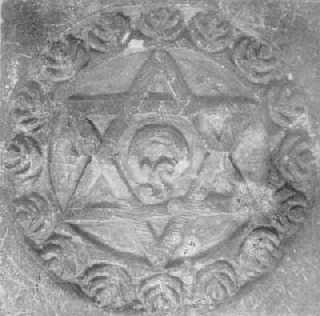
|
|||||||||||||||||||||
|
| |||||||||||||||||||||
Kataragama Mahā Dēvālē
|
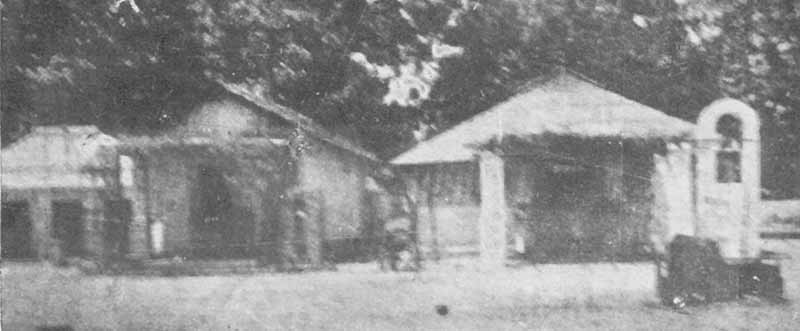
|
|
Kataragama devales as they appeared in 1950
|
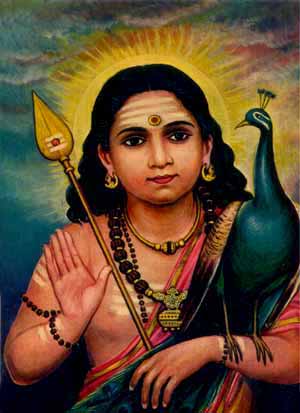 |
| Sri Jñāna Pandita: Murugan as Expositor of Gnosis with His symbols the Vēl Āyudha or Spear of Wisdom and vehicle/totem the Peacock - Phoenix. Behind Him rises the morning Sun symbolising the awakened state (bodhi) of the jñāni or Comprehensor. |
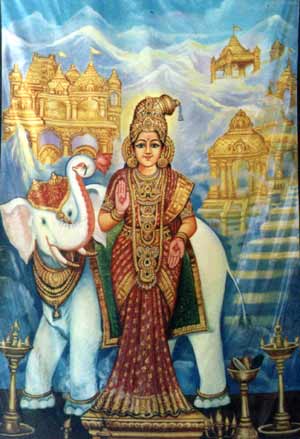
|
| Goddess Teyvanai Amman (Skt. Devasenā), Lord Murugan's spouse and presiding deity of Teyvanai Amman Kovil, Kathirkamam. (Temple curtain at Kathirkamam, 2001) |
As one circumambulates the Kataragama Mahā Dēvālē clockwise in the traditional way, after the completion of the worship in the inner sanctum of the Mahā Dēvālē and arrive at the U-turn on the left there is an archway that leads to the Sri Teyvanai Amman Temple. On the road outside facing the two temples are the two gateways leading to each temple. From the gates leading to the Sri Teyvanai Amman Temple you can proceed through the same archway to the Mahā Dēvālē.
The very physical layout of the temples itself conveys a deep spiritual meaning. The worship of the Lord at the Mahā Dēvālē leads to Jñāna Shakti, the power of wisdom and knowledge, which in turn leads to the power of Kriya Shakti (the energy of His action) embodied in the form of Sri Teyvanai Amman and the worship of Sri Teyvanai Amman at her temple leads one to the power of Jñāna Shakti at the Mahā Dēvālē.
Teyvanai Amman Temple
In legend and myth Teyvanai Amman, the daughter of Indra (Monarch of the Celestials) was the wife of the great Lord Kandaswami, who later married Valli Amman, the daughter of a Veddah chieftain in Kataragama. The spiritual essence of Valli Amman is Ichchā Shakti, the energy of desire.
Within the premises of Sri Teyvanai Temple is situated at the centre a shrine dedicated to Sri Teyvanai Amman. Beyond the painting of Sri Teyvanai Amman at the inner entrance to the shrine is a massive door leading to the sanctum sanctorum of the temple. Only the priests who perform the pujas have access to the sanctum sanctorum.
But on one night of the year immediately before the day of the teertham (Water Cutting Ceremony), which is the ceremony that concludes the Maha Festival in July, the sanctum sanctorum is opened to the devotees. The Brahmin priests sit before the image of Sri Teyvanai Ambal, whose eyes pierce through the body of the worshippers and reach into the inner recesses of their souls. Offerings are made by the devotees and the priest gives the blessings of Ambal by adorning the forehead of the devotees with kumkumam. On the right of Ambal is image of Shiva and on the left is the image of Vishnu. Two other Brahmin priests sit before these images and after the devotees pay their respects and give their offerings the priest sitting at the feet of Shiva adorns the foreheads of the worshippers with holy ash and the priest sitting at the feet of Vishnu places sandanam on the foreheads of the worshippers. This ceremony on this night is called “Ambal Darshanam”.
Guru Asanam
![Teyvanai Amman Matadipathi and devotees [12 kb]](../pix/teyvanai_kodiyetram2.jpg) |
Former Teyvanai Amman Mathadhipati the late Dattārāmagiri Swamigal and devotees, 1994 |
Beyond the outer mandapam of the temple ends is the building called the “Guru Asanam” (The Repose of the Gurus), which is so constructed that it appears to be an extension of the temple. This is an ancient building of stark simplicity befitting the Spartan asceticism of the sannyasins of the Sankaracharya Order of monks called the Dasanamis, the traditional trustees of the temple. The trustees lived in a room in this building in the hall in the middle is a portrait of Sri Kesopuri Swami and below this portraits are smaller photographs of the last two trustees, Swami Ramagiri and after Swami Dattaramgiri. At the foot of these are a pair of wooden clogs (used by Swami Kesapuri) and sacred books covered with a red cloth. The floor below is of dried cow dung, and the homam (The sacred fire) is kept burning on this floor. On the walls of the hall are hung the old photographs of the swamis whose matted locks and beards and ash-smeared bodies indicate their dedication to a life of asceticism and prayer at this holy site.
The rear compound is a flower garden. The small white flowers of the nandiawattai plant (gardenia) and the Queen of the Night are collected each day and used for the worship of Ambal and Palani Andavar. The tulasi plant is also grown here.
The rear compound of the Guru Asanam also contains the samadhis of Kesopuri Swami, and the other trustees of the temple, Mangalapuri, Surajpuri, Narayana Puri, Sukirtha Puri, Ratna Puri, and Ganesha Giri. Between two of the samadhis is the tomb of Balasundari, the daughter of an Indian rajah who, in fulfillment of a vow to Kandaswami, dedicated his firstborn Balasundari to service for Kanda Swami.
A flame is kept burning at the samadhi of Kesapuri Swami and, after pujas are performed to Ambal, the coiling smoke of the incense in the braziers and the lights flickering from the brass bowls of camphor are also taken by the priest to the tomb of Kesopuri by the priest who continues the worship at the samadhi.
The Palani Andavar Temple is situated at the left of the Sri Teyvanai Amman Temple and the Temple of Vairavar the guardian deity of the site is at the entrance to the Mahā Dēvālē from the Amman Temple.
The quarters of the priests and employees are on the right. Behind is the kitchen. Adjoining the kitchen is a spacious dining hall, which has been renovated by the administration after the departure of Swami Dattaramagiri to India in 1994. The dining hall has been paved with floor tiles and roofed with Metroof sheets. Throughout the fifteen days of the festival in July, pure and tasty vegetarian meals are served to pilgrims seated on the floor. About ten thousand people a day are given lunch and dinner. Large tapestries of Sri Theyvayani Amman and Pillaiyar hung on opposite sides of the hall overlook the pilgrims at the annadanam with their benevolent gaze and remind the devotees that it is through the munificence of Ambal and Pillaiyar that the meals are being provided.
Succession of Temple Trustees
Some centuries ago, the ascetic Kalyanagiri came over to Kataragama from India and performed severe penances and austerities at the banks of the Menik Ganga in order to obtain an audience with the God. During this period a little Veddah boy and girl attended to his needs. During the twelfth year of his austerities he fell asleep and was woken by the Veddah boy and girl.
|
The Satkona yantra, cut into black stone with the diagram of the Kataragama deity. Representation of flames along the periphery, the Tamil OM in the centre. In the Museum für Völkerkunde, Basel. From Wirz (1954) |
Infuriated, he chased the children shouting out that they had dared to wake him at the time he had fallen asleep for the first time. The children ran laughing and after clambering on a rock in the Ganga transformed themselves into the tender Lord Murugan and Valli. The awestruck Kalyanagiri prostrated himself at their feet and worshipped the divine couple. The Lord and Valli thereupon blessed Kalyanagiri and on their divine instructions he engraved the mystic diagram (the yantra) that is kept in the innermost sanctum of the Mahā Dēvālē.
This yantra represents the Uttama Rahasyam (the ultimate secret of the Divinity that cannot be comprehended except by His grace). This story is a beautiful parable conveying the meaning that the Lord and his consort Valli, unknown to the devotee, attends to the needs of the devotee and looks after him. Kalyanagiri resided at Kataragama and was the first trustee of the Sri Teyvanai Amman Temple Trust. When Kalyanagiri passed away, his earthly body was transformed into a muttu lingam (Lingam of Pearl) and a shrine was constructed over it and called the Muttulinga Swami Kovil, which at one time belonged to the Sri Teyvanai Amman Temple Trust.
The next trustee was Jayasingiri, the pupil of Kalyanagiri, who received Governor Brownrigg at Kataragama. He was succeeded by Mangalapuri, who died on or about the year 1873. Kesapuri, who had been the pupil of Mangalapuri for 70 years, succeeded him. Kesapuri executed the deed of trust No. 2317 of the 9th March 1898. This feed recognised the existence of this long standing trust and set out that the trustees should be sannyasins of the Order of Dasanamis founded by Sankaracharya belonging to one of the ten sects called Giri, Puri, Bharati, Saraswati, Vana, Aranya, Parvat, Asram, Tirtha and Bharat Tirtha.
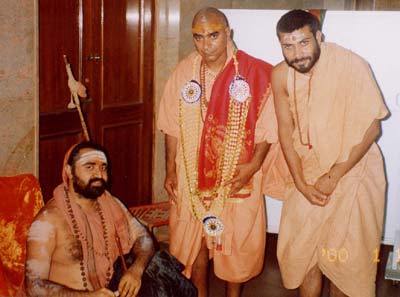
|
| HH Kanchi Sankaracharya (seated at left) appointed Purnanand Giri Swami (center) as Mathadhipati and Vigyananand Ashram Swami (right) as Deputy Abbot of Kataragama Teyvanai Amman Math in January 2000. |
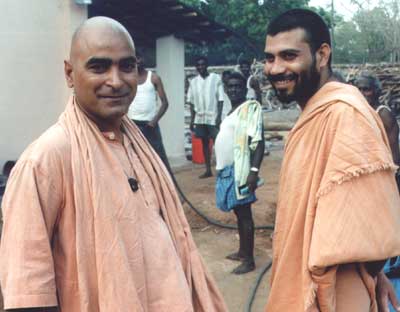
|
| Mathadhipati Pûrnānand Giri Swami (left) and his deputy Vigyānānand Ashram Swami direct the Temple's large-scale cooking operation during the 2001 Esala festival. |
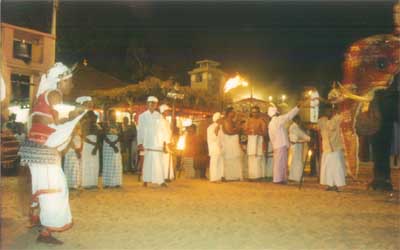
|
| Nightly during the fortnight-long Esala festival, white-clad kapurala shaman-priests perform a complex, carefully choreographed ritual in which the Kataragama god stealthfully emerges from his Mahadevale residence, rides in grand torchlit procession upon a caprisoned elephant to visit his sweetheart, the jungle princess Valli, and returns without being seen despite thousands of devotees straining to see him. The Kataragama God, mounted on a tusker at right, begins His nightly procession at Kataragama. His simple, unimposing Mahadevale residence can be seen in the background. |
The succeeding trustees were Surajpuri, Narayanapuri, Santhosapuri, Ratnapuri, Ganeshagiri, Ramagiri, and Dattaramgiri. The present trustee is Purnananda Giri. The names of all the trustees indicate that they were of the Order of Sannyasins mentioned in the deed of trust.
The Ganesha Temple situate next to the Mahā Dēvālē belongs to and is administered by the Sri Teyvanai Amman Temple Trust. The religious tradition that worship should commence first before the shrine of Ganesha before the worship is performed at any other shrine is faithfully followed at Kataragama. Before worship commences at the Mahā Dēvālē, the temple bell at the Ganesha Temple is pealed, and the Brahmin priests perform the worship at this temple. Then the worship at the Mahā Dēvālē is performed by the kapuralas. After this, worship at the Palani Andavar Temple at the Teyvanai Amman Temple commences, followed by the worship at the Sri Teyvanai Amman Temple Kovil. The last puja is performed at the Vairavar shrine.
The romance of the Great Lord and Valli the Veddah Princess, and the nuptials of the Great Lord Kanda Swami to Valli, is a living tradition followed each year. On the day of the New Year in April there is a procession from the Mahā Dēvālē to the temple of Valli, situated opposite the Mahā Dēvālē about 300 meters away to make the proposal of marriage and finalise the nuptials of the Great Lord to Valli.
Kataragama Esala Festival
The nuptials are celebrated on the 15-day festival in July, and end on the day of the Tirukona Natchathiram, which is the day of the teertham (the Water Cutting Ceremony). The exact time of the commencement of the festival is a secret known only to the kapuralas, the priests of the Mahā Dēvālē.
The festival commences at dusk with all the reverence and munificence the temple authorities can offer for the divine nuptials. Richly caparisoned elephants led by a magnificent tusker chosen to carry the sacred casket enter the temple premises their bodies swaying and waving their trunks. Troops of drummers and musicians and dancers enter and take their positions. A retinue of torch-bearers clad in ancient livery hold aloft encased atop iron poles burning copra which crackles and flames, keeping out the encroaching darkness of the night. There is an expectant hush as the pilgrims turn their gaze towards the main gates of the temple.
At the stipulated time the Basnayake Nilame, clad in the regalia of a Kandyan chieftain, but sans shoes and wearing white socks, and his retinue walk into the Mahā Dēvālē to the accompaniment of drums and flutes. The Nilame makes obeisance at the Maha Devale, the Ganesha Temple and the Vishnu Temple that adjoins the Ganesha Temple. The casket containing the mystic yantra covered by a cloth of rich tapestry is taken reverently by the kapuralas. The drums throb to a measured beat keeping time with the rhythm of the flutes as the casket is carried out and secured on the tusker elephant. Garlands of fragrant flowers are arranged in a bower around the casket and a kapurala sits astride the elephant with his two arms fastened securely around the casket.
As the elephant wheels around to take its first steps to go round the temple premises, the Trustee of the Sri Teyvanai Amman Temple who holds a coconut with camphor burning on it, raises the coconut above his head in salutation to the Great One and dashes the it to smithereens at his feet to indicate the blessings of the elder brother Ganesha to the ensuing nuptials. The elephant pauses before the Ganesha Temple and for about 15 minutes the Rajah Puja is performed by the Trustee. Holy ash is placed on the foreheads of the mahouts and the kapuralas. The forehead of the elephant is adorned by the Trustee with holy ash, sandanam and kumkumam. The tusker extends its trunk inviting the reward of fruits. The Trustee places sugar cane and a bunch of plantains into the mouth of the tusker who chomps on it lazily, flapping its massive ears.
The worship then commences with braziers containing incense of sweet breath coiling upwards in slow, hazy smoke being waived by the Trustee in the outlines of the mystic word “Om”. This is followed by the waiving of camphor in polished bowls of brass towards the casket atop the tusker. A small bell is tinkled incessantly by the Trustee during this period. The devotees fling petals and spray rose water upwards towards the casket. The tusker is impervious to the lights and the thronging crowds and stands patiently, coiling and uncoiling his trunk searching for fallen petals at his feet and shifting his feet from side to side.
Once the Rajah Puja has been completed, the tusker takes the first step forward. Immediately the drums beat, the flutes pipe music, the Kandyan dancers swirl and twirl in vigorous dance, the lissome maidens wave their hands and move their feet in a graceful formations, the nimble youth leap and move with quick movements to the rhythm of the flutes and the pounding drums. Happiness illumines their faces and sparkle through their eyes. Behind the Tusker walk groups of devotees chanting tevarams (devotional songs)
The procession wends its way round the Mahā Dēvālē and out of the main gates towards the temple of Valli, pausing briefly at the shrines on the way for the priests of each shrine to felicitate the Lord. The thrill of the Divine touches the hearts of the thronging devotees on the sidewalks who lift their hands in prayer with cries of Haro-Hara and Sadhu-Sadhu. Divinity is in the air like the gentle breeze that springs caressing the leaves of the trees.
The Trustee of the Sri Teyvanai Amman Temple has now arrived at the Valli Amman Temple. When the tusker arrives and the shrouded casket is taken out, the Trustee performs the aalatti (the traditional way of greeting the bridegroom as he enters the residence of the bride) by waving camphor gracefully before the casket as it is taken reverently by the kapuralas in to the inner sanctum of the Valli Amman Temple. The devotees worship the eternal Bridegroom and Bride at the temple. After the brief ceremonies at the temple, the shrouded casket is taken out, mounted on the tusker and the procession wends its way back to the Mahā Dēvālē.
The same ceremony is performed every night of the festival, but on the penultimate night (the night of the Ambal Darshanam) the resplendent full moon gazes down through the tree tops and showers its silver luminescence on the procession.
Who gives the patience to the elephants, the energy to the drummers, the flutists, the graceful maidens the nimble youth performing the dances, untiringly during the period of the three hours of the procession the happiness on all their faces, the rapture on the faces of the devotees? Who looks on this procession and showers more than he receives? You will know the answer.
Water Cutting Ceremony
The final day is the teertham (the Water Cutting Ceremony), which is on the Thirukonam Natchathiram. The casket is taken out at the time determined by the kapuralas covered with dried palm leaves and taken down the Menik Ganga to a specially constructed bower of branches and leaves to the accompaniment of the thunderous beating of the drums, the resounding sound of flutes, the vigorous pounding of feet of the kavadi dancers. Thronging crowds of thousands rush frenziedly up the river following the casket. As soon as the casket is dipped in the bower, and taken out the devotees rush to the bower pluck out the leaves and collect the water to be taken and placed in their shrines at home. Devotees splash water on each other and fling themselves into the river. Happiness fills the air. The pilgrims then depart to their homes with the inner glow that their pilgrimage has been rewarded.
During the month of November each year on the Tiru Karttikai Natchathiram day, the birthday of the Great Lord is celebrated with a procession of similar pomp and pageantry. This is followed immediately by Kanda Sasti (six days of fasting and prayer) by pilgrims at the Sri Teyvanai Amman Temple to commemorate the war of the Great Lord against the asuras that ended on the sixth day of the fast with the rout of the asuras.
The Great Lord thus lives in Kataragama with his consorts Teyvanai Amman and Valli Amman and the Teyvanai Temple is an indispensable part of this heritage.
A Pilgrim, 13th August 2000
| Living Heritage Trust ©2019 All Rights Reserved |
